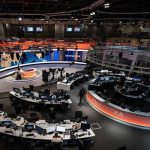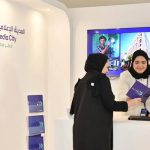Al Jazeera Media Network recently upgraded its Beirut bureau and built a new studio at the facility with Dubai-based United Broadcast and Media Solutions (UBMS) as the key systems integrator for the project. Beirut was the first in a series of more than 80 bureaus worldwide to be refurbished as part of the broadcasters drive to […]
 Al Jazeera Media Network recently upgraded its Beirut bureau and built a new studio at the facility with Dubai-based United Broadcast and Media Solutions (UBMS) as the key systems integrator for the project. Beirut was the first in a series of more than 80 bureaus worldwide to be refurbished as part of the broadcasters drive to modernise its infrastructure
Al Jazeera Media Network recently upgraded its Beirut bureau and built a new studio at the facility with Dubai-based United Broadcast and Media Solutions (UBMS) as the key systems integrator for the project. Beirut was the first in a series of more than 80 bureaus worldwide to be refurbished as part of the broadcasters drive to modernise its infrastructure
Al Jazeera Media Network recently commissioned a news bureau in Beirut, Lebanon to Dubai-based distributor United Broadcast and Media Solutions (UBMS). The bureaus main role is to offer live events and news coverage from Beirut and offer support to the main office in Doha.
To complement the completely redesigned state-of-the-art workplace environment produced by Al Jazeera’s Creative Division, UBMS procured, delivered, installed, tested and commissioned all of the equipment and handed over the completed project to the broadcaster earlier this year.
The new facility has been operational since then and is being used as a bureau for the network to gather and distribute news.
The bureau now hosts four fully-fitted edit rooms with voice-over capabilities, a media archive and storage, five DTL positions, a fully-fitted control room and a studio. All control rooms are based on portable equipment, so that in an emergency, equipment can be placed in travel cases and deployed on-site.
The three-camera studio has two sets and is being used for producing press reviews that broadcast every Tuesday with plans underway to produce documentaries and other news programming as well.
Ali Husseini, Head of Network Operations Standards, Compliance and QC, says the upgraded bureau in Beirut is a major step forward for Al Jazeera.
The Beirut bureau is the first in a series of upgrades that Al Jazeera Media Network has undertaken for all of its 80-plus bureaus. The facility is now equipped to handle news as a regional hub. We have always had a bureau in Beirut, but the new facility is bigger and technically more advanced. It has simplified the processes for correspondents and editors.
From two down-the-line positions, we now have five down-the-line positions, which is a major stride. In breaking news situations or when we need to cover a major story live, the facility is usually busy providing guests and correspondents, the capacity depends on how many simultaneous live takes can be done. We can do up to five at the same time with different feeding points that vary from 3G tools to fixed SNGs, while the newsroom carries on doing its functions, he explains.
A team of 35 operates from the bureau, including correspondents, video editors, engineers and operational staff. The bureau is connected to the hub in Doha to transmit content through two SNG hubs in the bureau for playout. The transfers are also carried out via file-based delivery workflows using FTP accelerators, FileCatalyst and Quicklink file transfer.
The new facility in downtown Beirut equips the team to produce live windows in studios with rolling news. This makes newsgathering and processing quicker and easier for correspondents.
Correspondents and cameramen are now able to access the archive database of the network, which means they can view and process their clips on their desktops. A studio location means a proper setup for interviews with talents who dont have offices, explains Husseini.
The Beirut bureau is a replica of the newsroom at the headquarters in Doha but on a smaller scale, yet it is able to serve the same functions. That means crews on the ground are no longer isolated, but it is as if they are sitting with their colleagues in the headquarters.
Husseini adds that the crew had to constantly scout for locations to shoot their stories before this setup was established.
They would shoot in cafés and other public places in the absence of a full-fledged studio.
The switchover from the old to the new studio was seamless, he says.
We were mindful of the fact that the switch had to have zero impact on broadcast. The changeover to the complete technical fit-out was achieved in three to four hours. We rehearsed for a week for the switch before going live.
The main challenge in the process was the time constraint. Time is always a challenge and the changeover had no room for error. The old and the new bureaus were running in parallel to ensure a seamless switch.
The Beirut bureau is a busy one with all that is happening in the region; our coverage highly depends on its contribution. I must add here that the Beirut bureau management was really supportive and enthusiastic; nevertheless they were keen not to interrupt the contribution, so we deployed a team in the old bureau and we did the switchover, where the standby team was ready to roll back in case something happened, says Husseini.
The setup
It was a single-site project that involved a studio, control room and server rooms for the bureau, Peter Kyriakos, Head of Marketing at UBMS, explains.
UBMS has a free zone warehouse in Dubai where all the equipment was brought in before distribution to Lebanon.
The project required extensive knowledge on the part of the engineers who did the implementation, in order to give the best solution and integrate the systems based on the requirements of the end user. Five of our engineers were deployed on-site to see the project through to completion and ensure the end user got what they were looking for, comments Kyriakos.
The main studio in the bureau uses three Sony PMW-500 cameras with Canon HJ17ex 6.2IRSE lenses. The studio can handle the production of news bulletins, analysis and talk shows.
Kyriakos explains: The end user required a turnkey project that offered the entire broadcast chain right from production to transmission. So, alongside the production facility, we handed over the broadcast infrastructure as well, complete with a studio control room, gallery and edit suites.
The studio control room has a Data Video HS-2000 HD switcher, 500 GB LaCie external HDD with USB and Firewire, Fostex 603 1B audio monitor, Sony BVM-F250A professional monitor, Allen&Heath Mix Wizard 3 12:2 Audio Mixer and Prospect TC-22 telephone hybrid. The glue used is from Miranda and also installed is an ETC SmartFad ML lighting desk. The Tektronix WFM5200 multi-format, multi-standard compact waveform for monitoring.
The studio also boasts three edit stations with Avid Media Composer running on MacBook Pro, with a 2TB Thunderbolt external hard drive supported by EditShare 16TB shared storage, which is at the core of the facility, offering central storage system for the project. It allows multiple editors and creative contributors access to all media from a central store. The entire process is transparent, enabling writing to the same volume simultaneously. EditShare also supports project sharing and bin locking for Avid, Adobe and Apple NLEs.
According to David Castle, Regional Manager for the Middle East at EditShare, the latest tools make day-to-day administration easy, with individual project management and dynamically resizable storage spaces.
The system is enormously flexible and lets you manage multiple projects according to the needs of the organisation, the Beirut bureau in this case, and the individual users. The system also comes with 4K capabilities built-in and a fully scalable architecture, comments Castle.
EditShare engineer Adrian Poole worked with engineers from UBMS, who reported that the editors using the system found it extremely convenient to ingest media and then have access to the folder structure, complete with all their own content. This, he says, is the system’s key strength.
The main area where the bureau can expand and scale is the storage and archiving systems from EditShare. These are connected through a 10G fibre connection with Cisco through the editing workstations. The entire system is flexible and scalable for further expansion and growth.
















































































